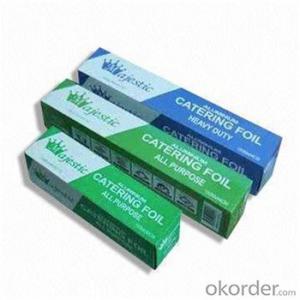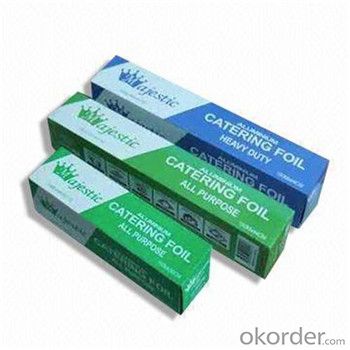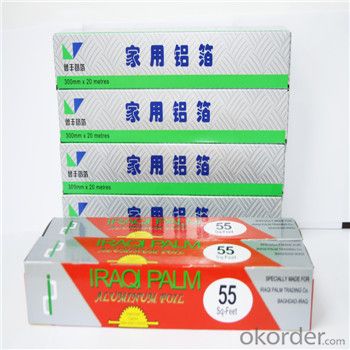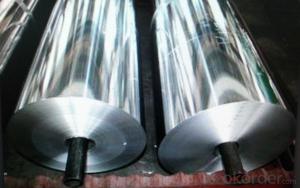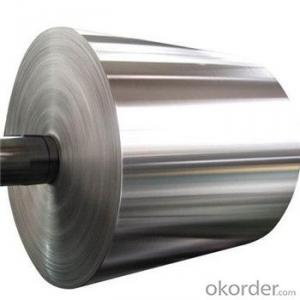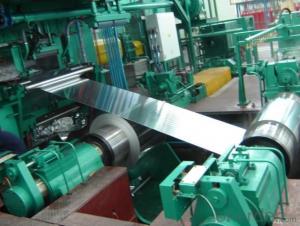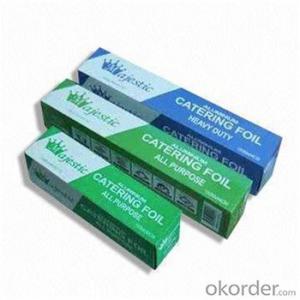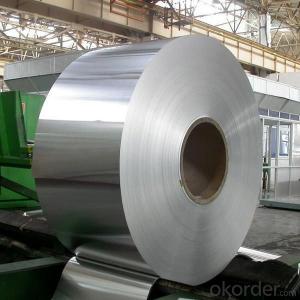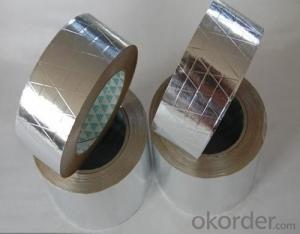Aluminum Sheets 4x8 Lowes - Jumbo Roll Household Aluminium Foil for Food Wrapping
- Loading Port:
- China main port
- Payment Terms:
- TT OR LC
- Min Order Qty:
- 3 m.t.
- Supply Capability:
- 10000 m.t./month
OKorder Service Pledge
OKorder Financial Service
You Might Also Like
Specification
1.Description of Aluminium Foil Jumbo Roll Household Foil for Food Wrapping
Denomination:Aluminium Foil For Food
Final Application:Aluminium Foil For Food
Alloy&Temper: 8011-O
Thickness: 0.03--0.007mm
Width:200mm--700mm
we are specialized in producting aluminum foil.
2.Why you want to choose us?
We've been specialized in aluminium foil for more than ten years, we know this product very well, we know what is good, what is the market price.
3.Specification and Application of Aluminium Foil Jumbo Roll Household Foil for Food Wrapping
Alloy: 8011
Temper: O
Thickness: 0.08-0.2mm
Core ID: 76mm, 150mm, 152mm
Width: Variety
Application: Food Wrapping
4.Pictures of Aluminium Foil Jumbo Roll Household Foil for Food Wrapping
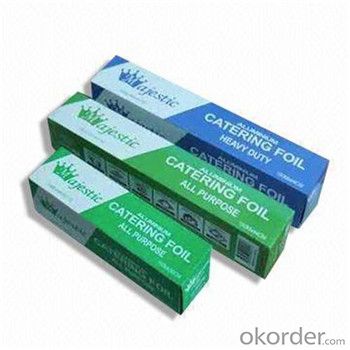
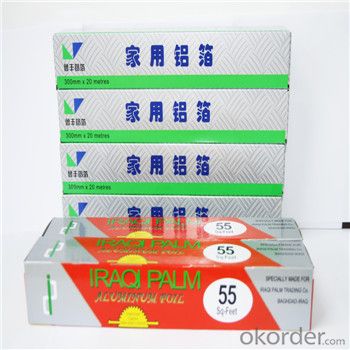
5.FAQ
1) How about your company?
A world class manufacturer & supplier of aluminum coil and alloy blanks. Aluminum production base is comprised of 18 aluminum annealers, 10 coil and foil mills, 4 continuous production lines, 2 hot rolling production line and 3 prepainted lines.
Export 5000 tons per month to Asia, America and Middle East. Always do the best for our clients.
2) Can you guarantee the quality of the products?
We are responsible for the quality of materials to get a long-term cooperation with clients in a reasonable period of time and we are glad to arrange and coordinate any third party inspection for you.
3) What is the delivery time after purchase?
35 day after receiving client’s deposit or correct LC
- Q: What are the safety precautions when working with aluminum sheets?
- When working with aluminum sheets, it is important to take certain safety precautions to ensure your well-being. Here are some key safety measures to follow: 1. Personal Protective Equipment (PPE): Always wear appropriate PPE, such as safety goggles, gloves, and a face mask, to protect yourself from potential hazards. Aluminum sheets may produce sharp edges, metal filings, or dust particles that can cause injury if they come into contact with your eyes, skin, or respiratory system. 2. Ventilation: Ensure that the work area is well-ventilated to minimize the buildup of aluminum dust or fumes. Proper ventilation helps in preventing the inhalation of harmful airborne particles, especially when cutting or shaping aluminum sheets. 3. Handling and storage: Handle aluminum sheets with care to avoid injuries. They can have sharp edges, so it is essential to wear gloves while handling them. Additionally, store the sheets in a secure and organized manner to prevent accidents like tripping or falling. 4. Cutting and shaping: When cutting or shaping aluminum sheets, use appropriate tools designed for this purpose. Avoid using tools that are not suited for aluminum, as they may cause damage or create unsafe conditions. Ensure that the cutting area is clear of clutter, and be mindful of your body position to avoid accidents. 5. Fire safety: Aluminum is a highly flammable material, so it is crucial to be cautious of fire hazards. Keep flammable materials away from the work area, and avoid using open flames or sparks in the vicinity. In case of a fire, have a fire extinguisher readily available and know how to use it effectively. 6. Training and knowledge: It is important to have proper training and knowledge about working with aluminum sheets. Understanding the properties of aluminum, the appropriate techniques, and safety precautions can help prevent accidents and injuries. 7. Regular maintenance: Keep your tools and equipment in good working condition. Regularly inspect them for any damage or wear and tear, and replace or repair as necessary. Faulty or poorly maintained tools can increase the risk of accidents when working with aluminum sheets. By following these safety precautions, you can minimize the potential risks and ensure a safe working environment when handling aluminum sheets.
- Q: What is aluminium oxide sheet?
- The oxidation of aluminum in natural and chemical oxidation, and oxidation of several, generally refers to the chemical oxidation oxidation plate plate, is the use of chemical reaction to aluminum formed on the surface of a white coating can reach the anticorrosion effect, can also be made, through technology, color, color, texture
- Q: I need to know what composite bats do and how (or if) they are better than aluminum bats.
- A okorder
- Q: I need some aluminum sheets for an art project. I'm not sure where to find such a thing, though. I've looked at Home Depot briefly and aluminum flashing is the closest thing I've found. Flashing comes in a roll and is just a bit too thin. I need flat sheets of aluminum that are somewhat stiff, but not more than, say, 1/4 thick. Are there any stores that sell such things? A larger sheet would be fine if I could either get it cut at the store or find some way to cut it to the size I want. How do you cut aluminum, anyway? Any suggestions are greatly appreciated!
- For sheets of aluminum I always go to a Commercial print shop. they use large sheets of aluminum for printing posters and things. It will have some kind of printing on one side but they can tell u what to use to remove it. It is fairly cheep. I usually pay scrap aluminum price for it I is thick enough to use for craft projects or even like I did made homemade shingles to reroof my house with. Took me 2 winters to make enough shingles. To cut it just lay a straight edge and scribe it with a sharp instrument. and it will break clean..
- Q: This question asks about the effects of using aluminum sheets in the construction industry on the environment.
- <p>The environmental impacts of using aluminum sheets in construction are multifaceted. On the positive side, aluminum is lightweight, which reduces energy consumption during transportation. It is also recyclable, with a high percentage of construction aluminum being recycled, reducing waste. However, the production of aluminum is energy-intensive, contributing to greenhouse gas emissions. Additionally, mining for bauxite, the primary source of aluminum, can lead to habitat destruction and water pollution. Despite these concerns, aluminum's durability and resistance to corrosion can extend the lifespan of buildings, reducing the need for frequent replacements and thus the overall environmental footprint over time.</p>
- Q: What is the surface hardness of aluminum sheets?
- The alloy and treatment process play a role in determining the surface hardness of aluminum sheets, which can vary. In comparison to metals like steel or titanium, aluminum sheets generally have a lower surface hardness. However, heat treatment can enhance the hardness of certain aluminum alloys. For instance, 6061-T6 aluminum sheets exhibit a surface hardness of approximately 95 Brinell, whereas 7075-T6 aluminum sheets have a surface hardness of around 150 Brinell. It is worth mentioning that these values are approximate and subject to variation based on the particular alloy, temper, and processing conditions.
- Q: Can aluminum sheets be used in automotive applications?
- Yes, aluminum sheets can be used in automotive applications. Aluminum is a lightweight and durable material that offers a variety of benefits for automotive manufacturing. It is commonly used in the production of car bodies, hoods, doors, roofs, and other components. The use of aluminum sheets in automotive applications helps to reduce the overall weight of the vehicle, which improves fuel efficiency and performance. Additionally, aluminum has excellent corrosion resistance properties, making it ideal for withstanding harsh weather conditions and road salt exposure. Furthermore, aluminum can be easily formed and shaped, allowing for complex designs and intricate detailing on automotive parts. Overall, the use of aluminum sheets in automotive applications contributes to the production of lighter, more fuel-efficient, and aesthetically appealing vehicles.
- Q: Are the aluminum sheets suitable for outdoor applications?
- Indeed, aluminum sheets prove to be fitting for outdoor applications. Renowned for its remarkable resistance to corrosion, aluminum emerges as a prime selection for outdoor utilization. Its immunity to rust and deterioration in the presence of moisture or harsh weather conditions solidifies its status as an ideal candidate. Moreover, aluminum sheets possess the advantageous combination of being lightweight, yet sturdy and long-lasting, rendering them appropriate for an assortment of outdoor applications such as roofing, siding, gutters, and outdoor signage. Additionally, they demonstrate ease of maintenance and can be adorned with paint or protective coatings to bolster their aesthetic appeal and fortify their defense against the elements. All in all, aluminum sheets establish themselves as a dependable and adaptable choice for outdoor applications.
- Q: i added aluminum sulfate to the soil from the bag with out mixing it with water and my hydrangeas look very sad. It burned them i guess... What is best thing to do to take some of it out or all if i can? will adding large amounts of water to the soil help it clear or will it make it worse? please before they die!!!10points!!!
- Aluminum sulfate lowers the pH of soil (increases the acidity). To increase the pH, you need to add lime. The ideal pH for most plants is around neutrality, or pH = 7. I can't tell you how much lime to add, since I don't know how much aluminum sulfate you added. Try to add roughly the same amount as the aluminum sulfate and see if that helps. Overwatering may help some, as it will leach out some of the acid.
- Q: I need to coat a piece of aluminum with aluminum oxide. Can I do it by just attaching aluminum to an electrode and put it into some water with the other electrode? I know you can make iron oxide that way, but will aluminum work? If it will work, which electrode should I put the aluminum on?
- The way I remember it is a cathode is like a catheter because they both receive stuff and the anode is the opposite of that) So, if you break apart Al2O3 you have 2Al^3+ and 3O^2-. Al^3+ goes to the cathode to receive electrons and become a neutral metal. O^2- goes to the anode to donate electrons and become O2 gas. Hope the analogy and explanation helps!
Send your message to us
Aluminum Sheets 4x8 Lowes - Jumbo Roll Household Aluminium Foil for Food Wrapping
- Loading Port:
- China main port
- Payment Terms:
- TT OR LC
- Min Order Qty:
- 3 m.t.
- Supply Capability:
- 10000 m.t./month
OKorder Service Pledge
OKorder Financial Service
Similar products
Hot products
Hot Searches
Related keywords
